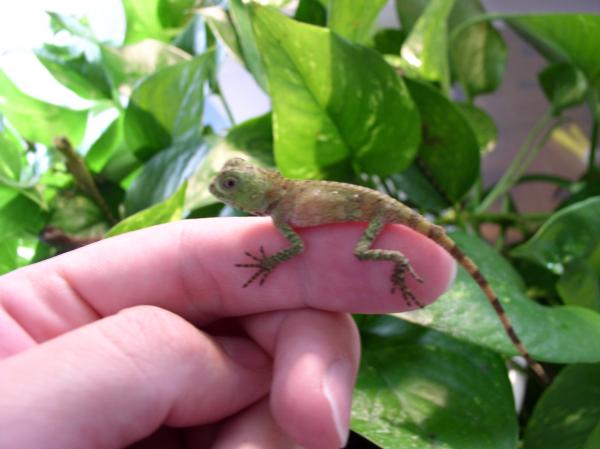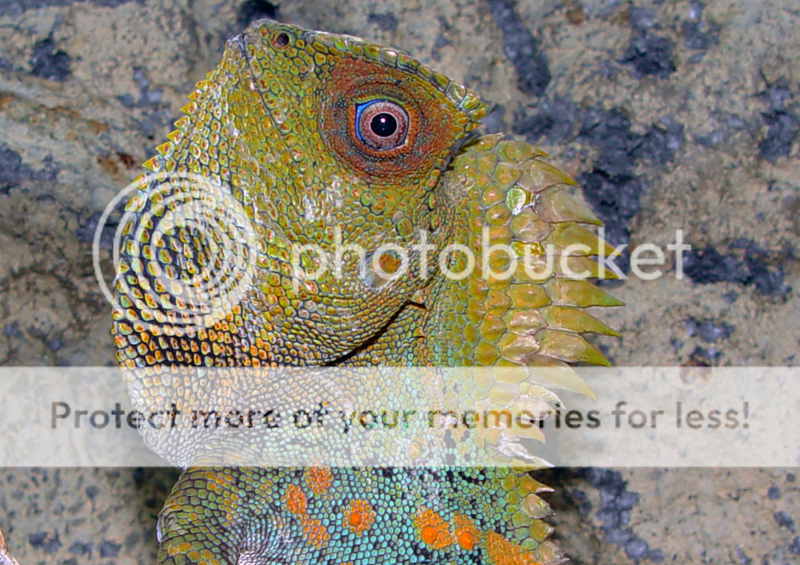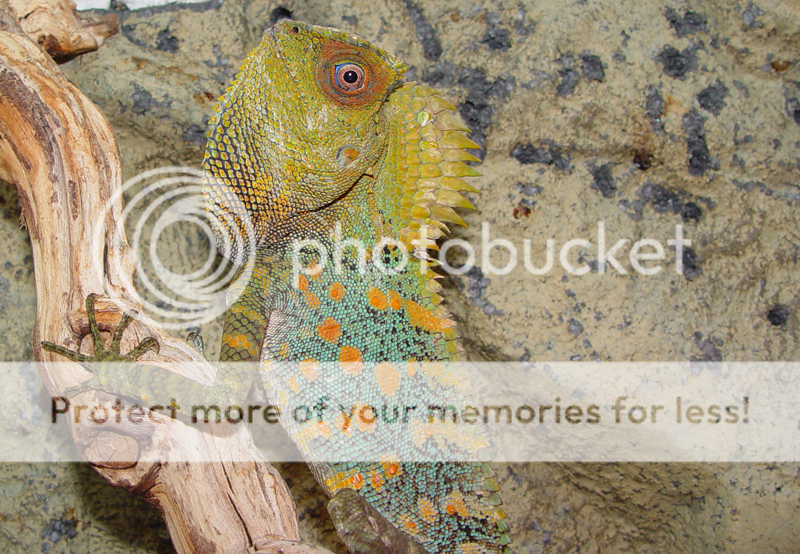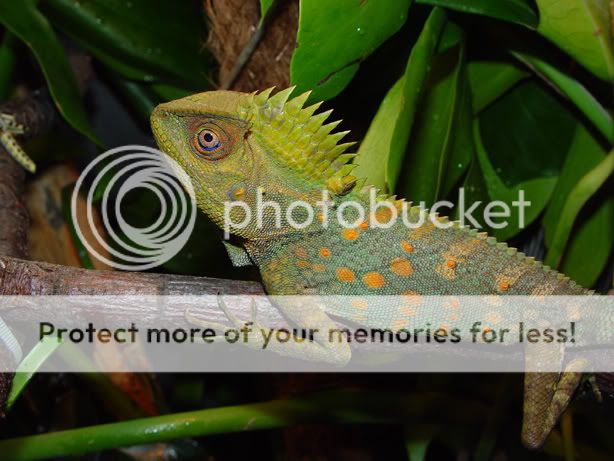Navigation
Install the app
How to install the app on iOS
Follow along with the video below to see how to install our site as a web app on your home screen.
Note: This feature may not be available in some browsers.
More options
You are using an out of date browser. It may not display this or other websites correctly.
You should upgrade or use an alternative browser.
You should upgrade or use an alternative browser.
Gonocephalus chamaeleontinus
- Thread starter Karen
- Start date
ijmccollum
New Member
Yes, he certainly looks like a handful -- he's got attitude written all over 'em. Very lovely though.
Aminah Undone
New Member
I had to bring this back from the archives..
One of my fb friends posted a pic of one, this morning. I haven't had coffee yet, so I took about three 2nd looks and then decided it had to be photoshop'd ..some kind of dragon stuck on a nice Veiled's body. Had to be! LOL!
I am ecstatic to find that a Gonocephalus chamaeleontinus actually exists!!!
Yours is fantastic, but I have to admit... he does indeed look a little ornery!
One of my fb friends posted a pic of one, this morning. I haven't had coffee yet, so I took about three 2nd looks and then decided it had to be photoshop'd ..some kind of dragon stuck on a nice Veiled's body. Had to be! LOL!
I am ecstatic to find that a Gonocephalus chamaeleontinus actually exists!!!
Yours is fantastic, but I have to admit... he does indeed look a little ornery!
Aminah Undone
New Member
It's similar to some other "dragons". It's an Agama. I think the common name is Forest Dragon or some such. (I don't like common names very much  )
)
ataraxia
Avid Member
It's similar to some other "dragons". It's an Agama. I think the common name is Forest Dragon or some such. (I don't like common names very much)
i have a gonocephalus chamaeleontinus. they are part of the angle head family. iguana cousins i guess
fluxlizard
Avid Member
the one that started this thread is very healthy and beautiful.
They used to come into the USA in terrible shape.
They are probably the most difficult lizard I've acclimated.
here's one of my babies on my finger-

Now that I look at it, I can see a few more in the plant above my hand.
I should have kept the babies when they hatched.
I haven't seen adults in years and I never got eggs again...
The babies were hardy though, very unlike the adults.
I kept mine cooler- not warm. And they were very territorial- 2 adults in the same cage and they wouldn't move so they had to be kept alone.
The eggs were incubated cool too- around 70 if I remember rightly.
And the adults were terribly parasitized- huge worms in the poop. terribly dehydrated and stressed.
The babies were much more tolerant of each other and hardy. I raised them cool though. My understanding from what I read at the time was that they lived in cool "hollers" on the mountainsides near streams and not a lot of direct sunlight...
They used to come into the USA in terrible shape.
They are probably the most difficult lizard I've acclimated.
here's one of my babies on my finger-

Now that I look at it, I can see a few more in the plant above my hand.
I should have kept the babies when they hatched.
I haven't seen adults in years and I never got eggs again...
The babies were hardy though, very unlike the adults.
I kept mine cooler- not warm. And they were very territorial- 2 adults in the same cage and they wouldn't move so they had to be kept alone.
The eggs were incubated cool too- around 70 if I remember rightly.
And the adults were terribly parasitized- huge worms in the poop. terribly dehydrated and stressed.
The babies were much more tolerant of each other and hardy. I raised them cool though. My understanding from what I read at the time was that they lived in cool "hollers" on the mountainsides near streams and not a lot of direct sunlight...
Last edited:
Aminah Undone
New Member
Thanks for the info, fluxlizard.. it is much appreciated. I am very tempted to add these to the collection and I haven't found much on care, at all.
DavidBuchan
New Member
First, Karen - cool lizard, I've never seen one before...
2nd, Fluxlizard - I wish you'd kept some so I can only begin to imagine how you might regret it......
3rd I found a bit more info, but I don't know for certain if it's true:
The scientific name is Gonocephalus chamaeleontinus and they get called many common names such as tree dragon, forest dragon, chameleon dragon, blue eyed tree dragon, angle headed dragon and the list goes on.
They are arboreal and come from Indonesia/ Malaysia. They require high humidity with regular sprays and a water bowl to soak in - so far I have found that hydration is critical - they seem to drink after they see/feel the spray of water, sticking their heads into the substrate trying to drink the water that collects. In the wild they are known to eat insects, earthworms and molluscs - they appear to be put off eating if you are watching them. They do appear to be quite stressy too but they are fascinating to watch with their territorial behaviours and unusual colouring/head shape. They will gape and jump sideways as well as tail whip if feeling threatened.
Some drank when placed into water - but seemed to need to see it moving first.
Now the most experienced breeder I spoke to keeps his very dry - which I do not understand as they originate from areas which are humid. Having visited Indonesia a few times now I believe that keeping them with low humidity is not the way to go. I believe they require a humidity kept above 70%. I also believe that ventilation is important too, with such high humidity and warmth, bacteria multiply rapidly ventilation help reduce this problem if good hygiene practice is employed as well.
I have also spoken to a herpetologist friend who lives in Indonesia and he agrees with me that they are more crepuscular than diurnal. The only book reference I have found about them is a book about Agamids which states they are crepuscular too. The book is titled Agamid Lizards and is written by Ulrich Manthey and Norbert Schuster published in 1996 by TFH publications. The book gives little info on this species but basically states that they are found on vertical tree trunks and diagonal branches and streams are never more than 100 meters away. The authors claim that they also eat earthworms, winged ants and mice.
2nd, Fluxlizard - I wish you'd kept some so I can only begin to imagine how you might regret it......
3rd I found a bit more info, but I don't know for certain if it's true:
The scientific name is Gonocephalus chamaeleontinus and they get called many common names such as tree dragon, forest dragon, chameleon dragon, blue eyed tree dragon, angle headed dragon and the list goes on.
They are arboreal and come from Indonesia/ Malaysia. They require high humidity with regular sprays and a water bowl to soak in - so far I have found that hydration is critical - they seem to drink after they see/feel the spray of water, sticking their heads into the substrate trying to drink the water that collects. In the wild they are known to eat insects, earthworms and molluscs - they appear to be put off eating if you are watching them. They do appear to be quite stressy too but they are fascinating to watch with their territorial behaviours and unusual colouring/head shape. They will gape and jump sideways as well as tail whip if feeling threatened.
Some drank when placed into water - but seemed to need to see it moving first.
Now the most experienced breeder I spoke to keeps his very dry - which I do not understand as they originate from areas which are humid. Having visited Indonesia a few times now I believe that keeping them with low humidity is not the way to go. I believe they require a humidity kept above 70%. I also believe that ventilation is important too, with such high humidity and warmth, bacteria multiply rapidly ventilation help reduce this problem if good hygiene practice is employed as well.
I have also spoken to a herpetologist friend who lives in Indonesia and he agrees with me that they are more crepuscular than diurnal. The only book reference I have found about them is a book about Agamids which states they are crepuscular too. The book is titled Agamid Lizards and is written by Ulrich Manthey and Norbert Schuster published in 1996 by TFH publications. The book gives little info on this species but basically states that they are found on vertical tree trunks and diagonal branches and streams are never more than 100 meters away. The authors claim that they also eat earthworms, winged ants and mice.
fluxlizard
Avid Member
You did better than I if you've had one for 2 years so I'd pay more attention to you than me- I got several at the same time, and my experience is limited to that group- the first crashed within hours and the last held out nearly a year or so. Most were gone within several weeks. They were in terrible shape on arrival though. I kid you not when I say they pooped out the biggest worms I have ever seen- so large that I was amazed they could live in a lizard that size (at least 3" and my memory has it even larger, but I wonder if my memory is playing tricks on me so I'm gonna say 3 to be on the "safe" side).
Eggs were from a female gravid already, not my own breeding.
Mine were always alert during the day, but mine were never super active that I saw. They were very shy and would freeze up and sit still if I were around. They would also do this with each other- I tried keeping in large enclosures with lots of foliage- set up much like chameleons, misting system and everything. UV lighting and weak (40 watt) heat spots. At first I kept some in pairs, then I realized that the same lizards would be found in exactly the same location when I would return every day- nobody was trying to thermoregulate or move about and they were just sitting around giving each other the stink eye. So I separated.
I found a pretty good write-up in another language (maybe german? can't remember) and I went on that as far as temperatures and basic husbandry. It described them pretty much as I have already mentioned here- cooler loving species, high humidity, moving water, and gave incubation temperature that I used. Babies grew nicely at cooler temps too and were more active and interesting than the adults.
I would love to try these again some day, especially if I could get animals that looked as healthy as the one that started this thread, or CB babies again.
Eggs were from a female gravid already, not my own breeding.
Mine were always alert during the day, but mine were never super active that I saw. They were very shy and would freeze up and sit still if I were around. They would also do this with each other- I tried keeping in large enclosures with lots of foliage- set up much like chameleons, misting system and everything. UV lighting and weak (40 watt) heat spots. At first I kept some in pairs, then I realized that the same lizards would be found in exactly the same location when I would return every day- nobody was trying to thermoregulate or move about and they were just sitting around giving each other the stink eye. So I separated.
I found a pretty good write-up in another language (maybe german? can't remember) and I went on that as far as temperatures and basic husbandry. It described them pretty much as I have already mentioned here- cooler loving species, high humidity, moving water, and gave incubation temperature that I used. Babies grew nicely at cooler temps too and were more active and interesting than the adults.
I would love to try these again some day, especially if I could get animals that looked as healthy as the one that started this thread, or CB babies again.









